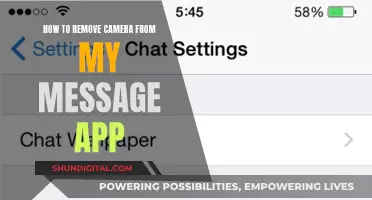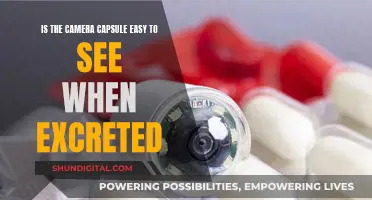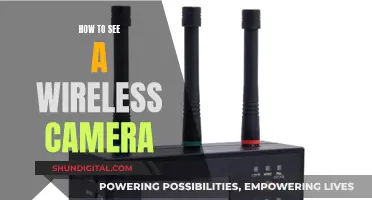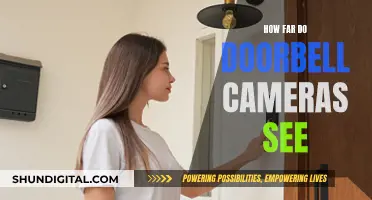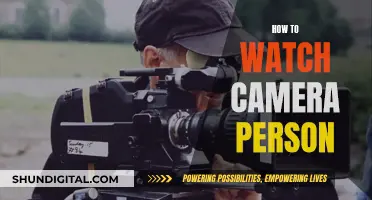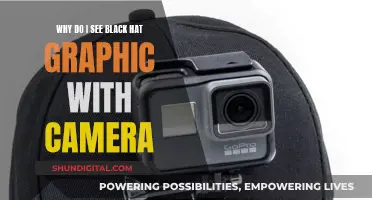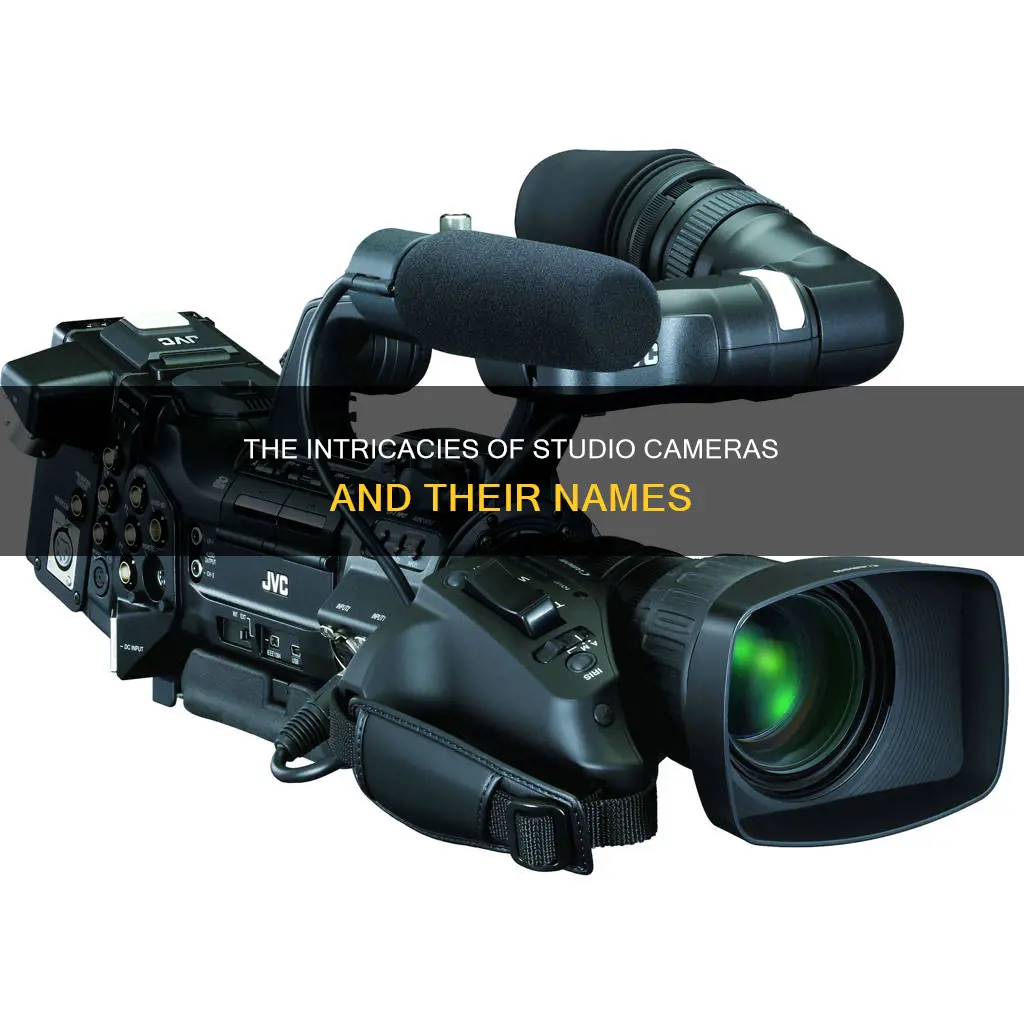
A television camera, or professional video camera, is a high-end device used to create electronic moving images. They are typically used in television studios, but can also be used outside the studio, for instance at public events. Studio camera operators are responsible for ensuring their equipment is in working order and that they are familiar with their show track. They work on sports television, news broadcasts, game shows, and sitcoms.
| Characteristics | Values |
|---|---|
| Name | Television camera, professional video camera |
| Use | Creating electronic moving images for television broadcasts, music videos, direct-to-video movies, corporate and educational videos, wedding videos, etc. |
| Image Sensor | CCD (Charge-Coupled Device) imagers, CMOS (Complementary Metal-Oxide Semiconductor) sensors |
| Image Quality | HD, 4K, 6K, HDTV, UHD |
| Image Resolution | 3840 x 2160p60, 6144 x 3456p50 |
| Image Format | RAW, ProRes, H.264/H.265/HEVC |
| Lens | Fujinon, Sony, Canon EF, Micro Four Thirds |
| Lens Features | Zoom, Focus Control, Active Lens Mount |
| Connectivity | HDMI, 12G-SDI, 10G Ethernet, USB Type-C |
| Control | Camera Control Unit (CCU), Camera Control License |
| Mount | Tripod, Boom, Crane, Pedestal, Handheld |
| Features | Tally Light, Viewfinder, ND Filters, Memory Card Slot, Remote Control |
What You'll Learn

Camera control units (CCUs)
In the past, broadcast cameras required large racks of control units, operated by skilled engineers, to produce usable images. These engineers, known as vision engineers, played a crucial role in setting up CCUs and ensuring broadcast-quality pictures. They worked closely with camera operators to adjust settings on both the camera and the CCU.
Today, modern cameras are more self-contained and may not always require a CCU. However, CCUs still offer significant benefits, especially in multi-camera productions. They enable cameras to be matched in terms of colour balance and picture intensity without relying on camera operators to make manual adjustments. This frees up camera operators to focus on other aspects of camerawork, such as blocking and image composition.
CCUs are typically used in conjunction with remote control panels (RCPs), waveform monitors, and vectorscopes to synchronise and match multiple cameras remotely. This technology allows for precise control over camera functions, ensuring maximum control and quality in television production.
The person operating the CCU units may be called a CCU Operator, Vision Controller, or Technical Director (TD). They are responsible for ensuring that all vision sources meet the technical requirements for broadcast and that the output is consistent and stable.
Using Altec Lansing Cameras on PC: A Guide
You may want to see also

Multi-camera setup
A multi-camera setup, also known as a multi-camera mode of production, is a method of filmmaking, television production, and video production. It involves the use of multiple cameras, either film or professional video cameras, to simultaneously record or broadcast a scene. This is in contrast to a single-camera setup, which uses only one camera.
In a typical multi-camera setup, the two outer cameras capture close-up shots of the most active characters or subjects, while the central camera or cameras capture a wider master shot to provide an overview of the entire scene. This approach offers several advantages over a single-camera setup. Firstly, it allows for multiple shots to be obtained in a single take, eliminating the need to start and stop the action for different camera angles. This results in significant time savings during filming and reduces the time spent on editing. It also simplifies continuity tracking and is particularly useful for high-output shows like daily soap operas.
However, there are also some drawbacks to using a multi-camera setup. One challenge is lighting, as the setup requires a compromise that works for all camera angles. Additionally, it can be more difficult to position equipment such as microphone booms and lighting rigs without them being visible in the shot. Multi-camera setups also require more storage space, as each additional camera used can increase the amount of film or digital storage needed. Furthermore, ensuring that all cameras are synchronous during editing can be more complex.
Despite these challenges, multi-camera setups are widely used in live television, including news, sports events, soap operas, talk shows, and sitcoms, especially those filmed before a live studio audience. They are valued for their ability to capture different angles and perspectives of a live situation as the action unfolds, enhancing the viewing experience and making it more engaging for the audience.
To achieve a successful multi-camera setup, it is important to have the right equipment, including multiple cameras capable of shooting in HD, a video switcher, and audio equipment. Additionally, multi-camera live streaming software, such as OBS Studio or Wirecast, can facilitate seamless transitions between camera feeds.
PennDOT Cameras: Live Access and Availability for Viewers
You may want to see also

Camera operators
Studio camera operators work with cameras mounted on pedestals that typically remain in fixed positions. They work on sports television, news broadcasts, game shows, and sitcoms, which are often recorded in a television studio. In a multi-camera setup, three or four stationary cameras are positioned across the front of the set to capture different angles, as well as wide shots and close-ups. Examples of sitcoms using this setup include Seinfeld and Friends.
During pre-show rehearsals, studio directors and assistant directors provide instructions to camera operators regarding the shots and angles each technician should capture. Rehearsals include blocking notes to help operators anticipate the talent's movements on set. Camera operators must be attentive to auditory cues from the director and the action on set, especially in live television production, where they need to be prepared to respond immediately to pick-up shots.
Studio camera operators are responsible for ensuring their equipment is in proper working order and familiarising themselves with their show track. While they are generally not accountable for repairing or maintaining studio cameras, it is beneficial for them to be trained in troubleshooting malfunctions. They must be experienced in using studio cameras and understand the method of multi-camera recording.
Operating a studio camera requires practice and finesse, as small movements by the operator result in exponentially larger shifts in the picture. Although operating a stationary camera on a pedestal reduces the burden of a handheld camera's weight, tilting and panning the camera still require strength, and muscle fatigue can set in after several hours of operation.
Stream Live Feed from Mercury Camera: A Step-by-Step Guide
You may want to see also

Camera types
The type of camera used in a TV studio depends on the type of show being filmed, the space available, and the production timeline.
Broadcast Cameras
Broadcast cameras are designed for live studio broadcasts. They are typically used in a multi-camera setup, where each camera is set up at a fixed viewpoint and controlled by a central control station. This allows the director to switch between different camera feeds in real time. Due to their substantial size, broadcast cameras are usually mounted on tripods or booms. They offer features such as colour correction, panning, zooming, and focusing. Examples of broadcast cameras include the Panasonic AK-HC5000 and the Sony HDC-3100L.
Professional Camcorders
Professional camcorders are compact and lightweight, making them ideal for use in both the studio and the field. They are designed to be used on a tripod or as a handheld camera. They often have built-in memory and HD-SDI outputs, providing flexibility in location selection.
Digital Cine Cameras
Digital cine cameras are suitable for TV series that aim for a film-like look and feel. While some models lack HD-SDI outputs, they deliver high-quality footage.
Compact Industrial and Multi-Purpose Cameras
These cameras are suitable for studios with limited space that do not require camera movement during filming.
The Camera's Uncomfortable Eye: Why Do We Hate It?
You may want to see also

Camera functions
Studio cameras are typically large, high-end devices that capture high-quality images and video footage for television broadcasting. They are an integral part of the television production process, especially for live or live-to-tape broadcasts. Studio cameras are often used in a multi-camera setup, where multiple cameras capture footage simultaneously from different angles. This setup is commonly used for newscasts, panel shows, interviews, sitcoms, game shows, and sports broadcasts.
Studio cameras are usually mounted on pedestals, tripods, or booms to ensure stability and smooth operation. They are often too heavy to be handheld and require strength to operate, even with weight balancing. These cameras are connected to a central control station, typically located outside the studio, where the director can switch between different camera feeds in real time. Studio cameras have the capability to capture a wide range of shots, including wide shots and close-ups, and the operator can adjust the focal length, lighting, and framing of each shot.
The camera operator plays a crucial role in the television production process. They work with digital, electronic, and film cameras in both multi and single-camera setups. The operator must follow a camera script, which outlines the order of shots, and receive cues from the director during the recording. In addition to creative visual skills, the operator must also have a strong understanding of the technology and equipment involved. While they are not usually responsible for repairing or maintaining the cameras, having some knowledge of troubleshooting can be beneficial.
Studio cameras have advanced significantly over time, evolving from mechanical devices to the digital cameras commonly used today. Modern studio cameras offer features such as live streaming and 4K HDR capture, enhancing the visual quality and functionality of television broadcasts.
Best Platforms to Watch Frights Camera Action
You may want to see also
Frequently asked questions
A TV studio camera is called a "broadcast camera".
Examples of broadcast cameras include the Blackmagic Design URSA Broadcast G2 Camera Kit, the Panasonic Lumix BS1H Box Cinema Camera, and the Sony HDC-3100L 2/3" CMOS Broadcast Camera Kit.
Broadcast cameras are designed for live studio broadcasts and are typically used in a multi-camera setup. They are connected to a central control station via cables, allowing a director to switch between different camera feeds in real-time. They are often mounted on tripods or booms to ensure stability and smooth operation.


